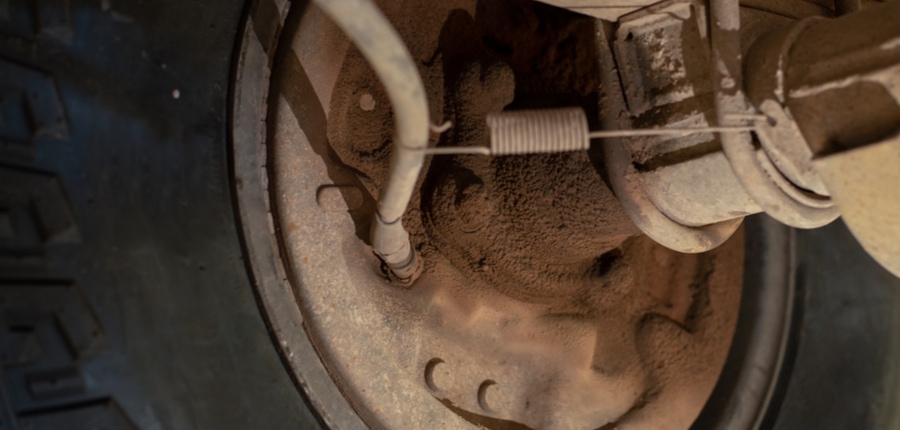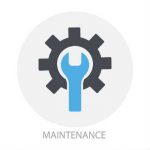Almost all front-wheel drive vehicles use CV axles to transfer engine power from the transaxle to the wheels. An axle seal holds the transmission fluid in at that point where the CV axle splines into the transaxle housing. In addition to keeping oil in, the seal keeps the grit and moisture out. The seal relies on a tiny amount of lubrication from the fluid it holds in to minimize wear.
Seal failures are usually due to simple wear and tear, most often noticed as fluid leaking out. A leaking axle seal is usually fairly easy to diagnose, being in a place where there aren’t often other sources for fluid to leak from.
A very slightly leaking seal that only leaves residue and doesn’t affect fluid levels may not be critical to replace. A leak significant enough to drip from the housing or leave puddles where the vehicle is parked should probably be addressed sooner rather than later.
Cost of Replacing the Axle Seal
On average, the cost to replace an axle seal is about $150.
For some specific examples of the axle seal leak repair cost in some common vehicles using $100 an hour as a labor rate are as follows:
- On a 2004 Toyota Corolla, the labor time for a front axle seal replacement (one side) is 2.6 hours and a Beck/Arnley seal costs about $7. Total job cost would be $267.
- On a 2014 Chevrolet Impala, the labor time for a front axle seal replacement is 1.2 hours. An OE AC Delco seal costs about $7. All of these make up for the total cost of around $127.
- On a 2005 Chrysler Pacifica AWD, there is an axle seal on each of the front and rear axles. The labor time for each is 1.1 hours. An OE axle seal is about $25 and an aftermarket SKF seal is about $13. The axle seal replacement cost in this instance will be around $123 using aftermarket parts or $135 using OE parts.
- The axle seal on the rear of a 2000 Ford Ranger takes 1.2 hours of labor time. A National seal costs about $7; making the job about $127 in total cost.
- On a 1999 Toyota Tacoma, the rear axle seal and bearing must be replaced together. The labor time for that is 1.7 hours, a Timken bearing is about $42, and the two seals needed for a side cost about $8. Total cost would be $220 all in all.
PRO TIP – If an axle seal is replaced in conjunction with other work that makes it accessible, such as a CV axle replacement, the additional labor for the axle seal is usually about two-tenths of the other labor charges.
Other Expenses That Might Come Up
A part of the procedure for replacing the axle seal is topping off the transmission to replace lost fluid. If the fluid is notably worn or past scheduled service, then, a transmission service would probably be recommended at the same time.
On rare occasions, a seal may fail not because of ordinary wear but because the bearing or bushing it protects has failed, allowing excess movement of the axle. Usually, in that case, noise or vibration would be noticed. However, if play in the transmission output shaft is found, more repairs may be needed.
PRO TIP – One general rule in automotive repair is that whenever a suspension part between the wheels is removed or replaced, checking the alignment is a good idea.
The axles must be removed to replace axle seals. In many cases, this can be done and reassembled without disturbing the alignment. However, this is not always the case and there are often several ways of disassembly to remove an axle depending on unpredictable conditions. If an alignment is recommended by the shop, it’s probably best to have it done.
It’s also a good idea if an alignment is not recommended to pay attention to how the vehicle drives after the repairs are done. If the steering wheel has changed position or any handling issues are noted, very likely an alignment should be done.
How To Repair/Replace Axle Seals?
In front-wheel drive vehicles, the metal housing of the seal grips the transaxle case, and the rubber lip of the seal rides on a machined surface of the axle. All-wheel drive vehicles often use the same kind of seal on all four axles if they have an independent suspension.
In some cases, the axle isn’t splined directly into the transaxle or differential but bolted to a flange that is splined in. Replacing an axle seal is nevertheless fairly simple in most cases. It involves removing the axle and the axle flange (if one is used), pulling the seal, installing a new seal, then reassembly.
Rear Axle Seal Replacement
There are a couple different varieties of axle seal on a solid rear axle. The first is as pictured below, where the seal is pressed into the tube of the differential, and the axle bearings are right in behind that. In that arrangement it’s often a good idea to replace the axle bearings with the seal, as problems with one can lead to problems with the other. In the second type the bearings are pressed onto the axle tube and the seal is behind them. In that arrangement the bearings must be replaced, as they are inevitably damaged during the removal process to replace the axle seal.

One common issue with both of these rear axle seal varieties is that when the seal leaks, it leaks into the braking system because of how it is placed. Most often if the braking system is contaminated with differential oil it is recommended that the brakes should be replaced; adding significantly to the cost. Rotors and drums can be cleaned, but pads or shoes that have absorbed oil are usually not considered reusable.
The replacement of a rear axle bearing on a solid axle vehicle has no impact on the wheel alignment.
FAQ
In most cases a little over an hour.
Indefinitely, but the leak may cause the transmission fluid to run too low, which can cause other expensive issues.
Generally not, as long as fluid levels are kept up. The exception would be a rear axle seal leak, where even a small amount of fluid leaking can damage the rear brakes.

